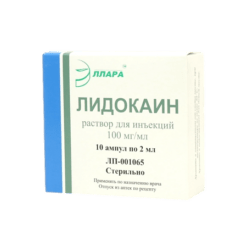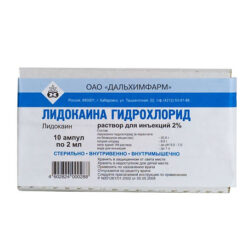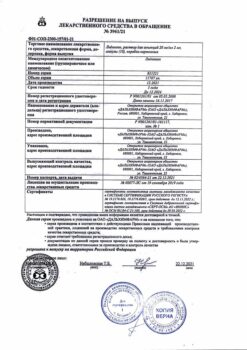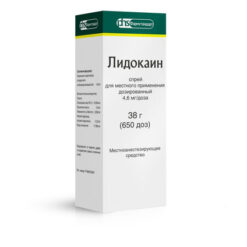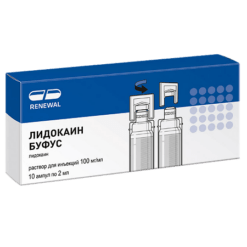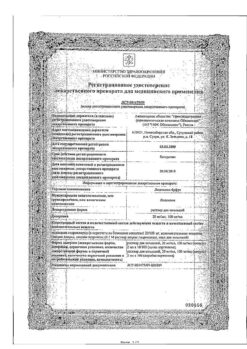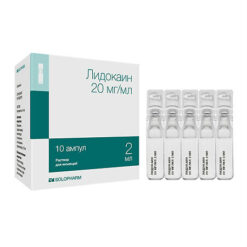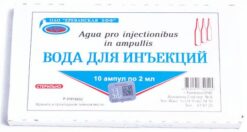No products in the cart.
Lidocaine-ACOS, 6 mg/dose 38 g
€1.00
Out of stock
(E-mail when Stock is available)
EAN: 4602565031787
SKU: 506785
Categories: Anesthesia and resuscitation, Local anesthetics, Medicine
Description
Pharmacotherapeutic group
Local anesthetic agent
ATX code: N01BB
Pharmacodynamics:
Lidocaine is an amide type local anesthetic.
The local anesthetic action is due to reversible inhibition of nerve conduction by blockade of sodium channels in the nerve endings, thus preventing generation of impulses at the end of sensitive nerves and conducting of pain impulses along the nerve fibers.
Lidocaine has a rapid onset of action, high anesthetic activity and low toxicity.
In local application it dilates blood vessels and has no local irritant effect. It has analgesic effect.
The effect shall develop 1-5 minutes after application to the mucous membranes or skin and shall last for 10-15 minutes.
Pharmacokinetics:
It is quickly absorbed from mucous membranes (especially pharynx and respiratory tract) the degree of absorption of the drug is determined by the degree of blood supply to the mucous membrane by the total dose of the drug, location of site and duration of application. After application to the mucous membrane of the upper respiratory tract it is partially swallowed and inactivated in the gastrointestinal tract.
The time of reaching maximum concentration (ÒCmax) in plasma when applied to the mucous membrane of the oral cavity and upper respiratory tract is 10-20 minutes. Protein binding depends on the drug concentration and is 60-80% at drug concentration of 1-4 µg/ml (43-172 µmol/L). Fast drug distribution (half-life (T1/2) of distribution phase is 6-9 min) goes first to well supplied with blood tissues (heart, lungs, brain, liver, spleen) and then to fat and muscle tissues. It penetrates through the blood-brain barrier and the placental barrier and is secreted with the mother’s milk (40% of the concentration in the mother’s plasma).
Metabolized in the liver (90-95%) with microsomal enzymes by dealkylation of the amino group and breaking the amide bond to form less active compared to lidocaine metabolites (monoethylglycincylidine and glycincylidine) with a T1/2 of 2 h and 10 h respectively. In liver disease the metabolic rate is reduced and is 50% to 10% of the normal value. It is excreted with the bile and the kidneys (up to 10% unchanged).
In chronic renal failure cumulation of metabolites is possible. Urinary acidification contributes to increased excretion of lidocaine.
Indications
Indications
The drug can be used for local anesthesia in the following cases:
in dentistry – for terminal (superficial) anesthesia: anesthesia of the injection area before local anesthesia; opening of superficial abscesses; before suturing the mucous membrane; before fixing crowns and bridges; in the treatment of gum inflammation and periodontopathies; extirpation of baby teeth; removal of tartar;
in otorhinolaryngology – operations on the nasal septum and removal of nasal polyps; conducting electrocoagulation in the treatment of nosebleeds; elimination of the pharyngeal reflex and anesthesia at the injection site before removing the tonsils; opening of peritonsillar abscesses; puncture of the maxillary sinus;
in obstetrics and gynecology – egsiotomy and incision processing; removal of seams; minor operations on the vagina and cervix; rupture of the hymen; treatment of thread suppuration;
for instrumental and endoscopic studies – before inserting a probe through the nose or mouth (including duodenal intubation and fractional study of gastric secretion); during rectoscopy intubation;
during radiographic examination – elimination of nausea and pharyngeal reflex;
as an analgesic (pain reliever) drug for burns (including sunburn); bites; contact dermatitis (including those caused by irritating plants); small wounds (including scratches);
superficial anesthesia of the skin during minor surgical interventions.
Pharmacological effect
Pharmacological effect
Pharmacotherapeutic group
Local anesthetic
ATX code: N01BB
Pharmacodynamics:
Lidocaine is an amide-type local anesthetic.
The local anesthetic effect is due to the reversible inhibition of nerve conduction due to the blockade of sodium channels in nerve endings, which prevents the generation of impulses in the endings of sensory nerves and the conduction of pain impulses along nerve fibers.
Lidocaine has a rapid onset of action, high anesthetic activity and low toxicity.
When applied topically, it dilates blood vessels and does not have a local irritating effect. Has an analgesic effect.
The effect develops 1-5 minutes after application to mucous membranes or skin and lasts for 10-15 minutes.
Pharmacokinetics:
It is quickly absorbed from the mucous membranes (especially the pharynx and respiratory tract); the degree of absorption of the drug is determined by the degree of blood supply to the mucous membrane, the total dose of the drug, the localization of the site and the duration of application. After application to the mucous membrane of the upper respiratory tract, it is partially swallowed and inactivated in the gastrointestinal tract.
The time to reach the maximum concentration (TCmax) in plasma when applied to the mucous membrane of the oral cavity and upper respiratory tract is 10-20 minutes. Protein binding depends on the concentration of the drug and is 60-80% at a drug concentration of 1-4 μg/ml (43-172 μmol/l). It is distributed quickly (half-life (T1/2) of the distribution phase is 6-9 minutes) first enters well-supplied tissues (heart, lungs, brain, liver, spleen) then into adipose and muscle tissue. Penetrates through the blood-brain and placental barriers and is secreted into breast milk (40% of the concentration in maternal plasma).
Metabolized in the liver (90-95%) with the participation of microsomal enzymes by dealkylation of the amino group and cleavage of the amide bond with the formation of less active metabolites compared to lidocaine (monoethylglycine xylidine and glycine xylidine) whose T1/2 is 2 hours and 10 hours, respectively. In liver diseases, the metabolic rate decreases and ranges from 50% to 10% of the normal value. Excreted with bile and kidneys (up to 10% unchanged).
In chronic renal failure, accumulation of metabolites is possible. Acidification of urine increases the secretion of lidocaine.
Special instructions
Special instructions
When using, the bottle should be kept in an upright position.
Avoid contact with eyes and respiratory tract (risk of aspiration). Requires special care when applying the drug to the back of the throat.
Application to the buccal mucosa is associated with a risk of dysphagia and subsequent aspiration, especially in children.
If the sensitivity of the tongue and mucous membrane of the cheeks is impaired, the risk of biting increases.
Lidocaine is well absorbed through mucous membranes (especially in the trachea) and damaged skin. This should be taken into account especially when treating large areas of tissue in children.
When using the spray during surgical operations in the pharynx or nasopharynx, it should be noted that lidocaine, suppressing the pharyngeal reflex, enters the larynx and trachea and suppresses the cough reflex, which can lead to bronchopneumonia. This is especially important in children since the pharyngeal reflex is more often triggered in them. In this regard, the spray is not recommended for local anesthesia before tonsillectomy and adenotomy in children under 8 years of age.
Caution should be exercised when applying lidocaine to damaged mucous membranes and/or infected areas.
The drug should be used with caution in patients with epilepsy, as well as bradycardia, impaired cardiac conduction, impaired liver function and severe shock, especially when absorption of a significant amount of the drug can be expected when large areas of tissue are treated with high doses.
Lower doses should be used in weakened and elderly patients with acute diseases, as well as in children – in accordance with age and general condition.
In children under 2 years of age, it is recommended to apply Lidocaine spray with a cotton swab soaked in the drug.
Impact on the ability to drive vehicles. Wed and fur.:
During the treatment period, care must be taken when driving vehicles and engaging in other potentially hazardous activities that require increased concentration and speed of psychomotor reactions.
Active ingredient
Active ingredient
Lidocaine
Composition
Composition
For 1 dose:
Active ingredient: lidocaine hydrochloride monohydrate (in terms of lidocaine hydrochloride) – 4.6 mg;
Excipients: ethanol 96% (rectified ethyl alcohol, “Extra” grade) – 18.4 mg, propylene glycol – 4.6 mg, sodium hydroxide (sodium hydroxide) – 0.23 mg, sodium saccharinate dihydrate (sodium saccharin) – 0.138 mg, racementol (racemic menthol) – 0.092 mg, purified water – up to 0.046 g.
Pregnancy
Pregnancy
There are no results from controlled clinical studies in pregnant women.
If it is necessary to use local anesthesia and there is no safer treatment, the drug can be used during pregnancy.
Lidocaine is excreted into breast milk; however, after normal therapeutic doses, the amount excreted in milk is too small to cause any harm to the nursing infant.
Contraindications
Contraindications
– Hypersensitivity to lidocaine or any other component of the drug;
– use of lidocaine in the form of a spray for tonsillectomy and adenotomy in children under 8 years of age.
With caution:
– Instrumental studies (rectoscopy) in patients with hemorrhoidal bleeding;
– local infection in the area of application;
– trauma to the mucous membrane or skin in the area of application;
– severe somatic pathology;
– epilepsy;
– bradycardia – cardiac conduction disorder;
– liver dysfunction;
– severe shock;
– concomitant acute diseases;
– weakened patients;
– pregnancy, breastfeeding period;
– younger children’s age;
– old age.
Side Effects
Side Effects
At the site of application of the drug: a slight burning sensation that stops after the onset of anesthesia (within 1 minute), erythema, swelling, impaired sensitivity.
Allergic reactions: possible allergic contact dermatitis (hyperemia at the site of application, skin rash, urticaria, itching), angioedema, anaphylactic shock.
Use of the drug should be discontinued if any allergic reaction occurs.
The frequency of systemic reactions after the use of lidocaine aerosol is extremely low because A very small amount of active drug is applied which can enter the bloodstream.
In the case of large doses, as well as rapid absorption of hypersensitivity and idiosyncrasy of poor tolerability of the drug, the following side effects from the central nervous system and cardiovascular system may be observed.
Systemic reactions may be observed from the central nervous system: headache, dizziness, convulsions, tremor, blurred vision, tinnitus, excitement and/or depression, feeling of fear, euphoria, anxiety, fever, feeling of cold, respiratory depression.
From the cardiovascular system: increased blood pressure, decreased blood pressure, bradycardia, arrhythmia, depression of myocardial function.
Other: urethritis (after local application).
Interaction
Interaction
Vasoconstrictors (epinephrine phenylephrine methoxamine) prolong the local anesthetic effect of lidocaine.
Cimetidine and propranolol reduce the hepatic clearance of lidocaine (decreased metabolism due to inhibition of microsomal oxidation and decreased hepatic blood flow) and increase the risk of toxic effects (including stunned state, drowsiness, bradycardia, paresthesia, etc.).
Barbiturates phenytoin rifampicin (inducers of microsomal liver enzymes) reduce the effectiveness of lidocaine (increased dose may be required).
When prescribed with ajmaline, phenytoin, verapamil, quinidine, amiodarone, the negative inotropic effect may be enhanced.
Co-administration with beta-blockers increases the risk of bradycardia.
Cardiac glycosides weaken the cardiotonic effect; curare-like drugs enhance muscle relaxation.
Procainamide increases the risk of developing central nervous system excitation hallucinations.
With the simultaneous administration of lidocaine and hypnotics and sedatives, their inhibitory effect on the central nervous system may be enhanced.
With intravenous administration of hexobarbital or sodium thiopental against the background of the action of lidocaine, respiratory depression is possible.
Under the influence of monoamine oxidase inhibitors (furazolidone procarbazine selegiline), the local anesthetic effect of lidocaine may be enhanced. Patients taking monoamine oxidase inhibitors should not be prescribed parenteral lidocaine.
With the simultaneous use of lidocaine and nolimixin, an increased inhibitory effect on neuromuscular transmission is possible; therefore, in this case, it is necessary to monitor the patient’s respiratory function.
Overdose
Overdose
Symptoms: increased sweating pale skin nausea vomiting dizziness headache blurred visual perception ringing in the ears diplopia decreased blood pressure bradycardia arrhythmia drowsiness chills numbness tremor anxiety agitation convulsions methemoglobinemia cardiac arrest.
Treatment: when the first signs of intoxication appear (dizziness, nausea, vomiting, euphoria), the patient is transferred to a horizontal position and oxygen inhalation is prescribed; for psychomotor agitation – 10 mg of diazepam intravenously; for convulsions – iv 1% solution of hexobarbital or sodium thiopental; for bradycardia – 05-1 mg of atropine sympathomimetic agents (norepinephrine phenylephrine) intravenously. Dialysis is ineffective.
Storage conditions
Storage conditions
In a place protected from light at a temperature not exceeding 25 ° C.
Keep out of the reach of children.
Shelf life
Shelf life
3 years.
Do not use after the expiration date indicated on the package.
Manufacturer
Manufacturer
Sintez, Russia
Additional information
| Shelf life | 3 years. Do not use after the expiration date printed on the package. |
|---|---|
| Conditions of storage | In the dark place at a temperature not exceeding 25 ° C. Store out of the reach of children. |
| Manufacturer | Sintez OAO, Russia |
| Medication form | dosage for local and external use |
| Brand | Sintez OAO |
Other forms…
Related products
Buy Lidocaine-ACOS, 6 mg/dose 38 g with delivery to USA, UK, Europe and over 120 other countries.


